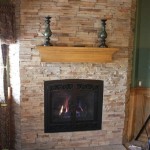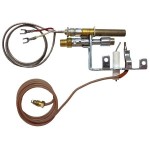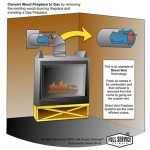```html
Propane Ventless Fireplace Logs: A Comprehensive Overview
Vented and ventless fireplaces offer distinct heating solutions, each with their own set of advantages and disadvantages. Propane ventless fireplace logs represent a specific type of heating apparatus designed to operate without the need for a traditional chimney or venting system. This article delves into the mechanics, applications, safety considerations, and installation aspects of propane ventless fireplace logs, providing a comprehensive understanding of this heating technology.
Understanding Ventless Fireplace Technology
Ventless fireplaces, also known as vent-free fireplaces, rely on advanced combustion technology to burn fuel, typically propane or natural gas, with a high degree of efficiency. The underlying principle is to combust the fuel so completely that minimal byproducts, such as carbon monoxide, are produced. This complete combustion allows the heat generated to be directly radiated into the room, eliminating the heat loss associated with vented systems where exhaust gases are expelled through a chimney.
The completeness of combustion is the critical factor determining the safety and effectiveness of ventless fireplaces. Manufacturers employ sophisticated burner designs and control systems to optimize the air-to-fuel ratio, ensuring that near-total combustion is achieved. Oxygen Depletion Sensors (ODS) are integral safety features in ventless fireplaces. These sensors constantly monitor the oxygen levels in the room. If oxygen levels drop below a pre-determined threshold, the ODS automatically shuts off the gas supply to the fireplace, preventing the buildup of harmful carbon monoxide.
Propane ventless fireplace logs are designed to mimic the appearance of a traditional wood-burning fireplace. The logs themselves are typically constructed from ceramic or refractory materials that are resistant to high temperatures. These logs are arranged strategically around the burner to create a realistic flame pattern and radiate heat effectively. The aesthetic appeal of ventless fireplace logs is a significant factor for many consumers, as they provide the ambiance of a traditional fireplace without the need for wood storage or ash cleanup.
Advantages of Propane Ventless Fireplace Logs
Propane ventless fireplace logs offer several advantages over traditional wood-burning fireplaces and vented gas fireplaces. One primary advantage is their high energy efficiency. Because they do not require a chimney, ventless fireplaces prevent the loss of heated air up the flue. This results in a significantly higher percentage of the heat generated being transferred directly into the room, leading to lower heating costs. Efficiency ratings for ventless fireplaces can often exceed 99%, making them a highly effective supplemental heating source.
Another advantage is the ease of installation. Ventless fireplaces do not require extensive construction work to install a chimney or venting system. This simplifies the installation process and reduces the overall cost. Many ventless fireplaces can be installed directly against a wall, making them suitable for a wide range of spaces. The only requirement is a connection to a propane gas supply, which can be achieved through a direct gas line connection or a portable propane tank.
The convenience and ease of use are also notable benefits. Ventless fireplaces can be turned on and off with the flip of a switch or the press of a button. Many models come with remote controls that allow users to adjust the flame height and heat output from a distance. This eliminates the need for manually adding wood to the fire and cleaning up ashes. The low maintenance requirements of ventless fireplaces make them an attractive option for homeowners seeking a hassle-free heating solution.
Furthermore, propane ventless fireplace logs can be used even during power outages, provided they are equipped with a battery backup ignition system. This is particularly advantageous in regions prone to winter storms or other events that can disrupt the electrical grid. The ability to provide heat during a power outage can be a significant safety and comfort benefit.
Safety Considerations and Proper Usage
While propane ventless fireplace logs are designed with safety features, it is crucial to adhere to safety guidelines and usage recommendations to ensure safe and reliable operation. Proper ventilation is paramount, even though the fireplace is ventless. It is essential to provide adequate fresh air to the room where the fireplace is installed. This can be achieved by opening a window slightly or ensuring that the room has sufficient air leaks.
Carbon monoxide detectors should be installed and maintained in the home, particularly near the fireplace. Carbon monoxide is a colorless, odorless gas that can be lethal if inhaled in sufficient concentrations. Regular testing of the carbon monoxide detector is essential to ensure that it is functioning properly. It is also important to be aware of the symptoms of carbon monoxide poisoning, which can include headache, dizziness, nausea, and confusion.
The size of the ventless fireplace should be appropriate for the size of the room. Using a fireplace that is too large for the room can result in overheating and excessive humidity. Manufacturers typically provide guidelines on the appropriate BTU (British Thermal Unit) output for different room sizes. It is important to follow these guidelines to ensure safe and efficient operation.
Regular maintenance is also crucial. The burner assembly should be cleaned periodically to remove any dust or debris that may accumulate. This can help to ensure proper combustion and prevent the formation of carbon monoxide. The oxygen depletion sensor should also be inspected regularly to ensure that it is functioning correctly. Any malfunctions or damages should be addressed promptly by a qualified technician.
Furthermore, it is imperative to follow the manufacturer's instructions for installation and operation. Improper installation can lead to safety hazards and void the warranty. If you are not comfortable installing the fireplace yourself, it is best to hire a qualified professional to do so. Familiarize yourself with the operating instructions and safety precautions before using the fireplace. Store propane tanks properly, away from direct sunlight and sources of ignition, if the unit uses a portable tank.
Installation and Maintenance Procedures
The installation of propane ventless fireplace logs typically involves connecting the fireplace to a propane gas supply, positioning the logs around the burner, and ensuring that the fireplace is stable and level. If connecting to a direct gas line, it is crucial to use a qualified gas fitter to ensure that the connection is made safely and in accordance with local building codes. The gas line should be properly sized and pressure-tested to prevent leaks.
If using a portable propane tank, ensure that the tank is properly connected to the fireplace using the appropriate fittings and hoses. The tank should be placed in a well-ventilated area, away from direct sunlight and sources of ignition. Regular inspection of the hoses and fittings is essential to check for leaks. Soapy water can be used to test for leaks; if bubbles form when the soapy water is applied to the fittings, it indicates a leak.
Once the gas supply is connected, the fireplace logs should be arranged around the burner according to the manufacturer's instructions. The logs should be positioned in a way that allows for proper airflow and prevents the burner from being obstructed. This is crucial for ensuring complete combustion and preventing the buildup of carbon monoxide. The placement of the logs also affects the aesthetic appearance of the fireplace, so it is important to arrange them in a visually appealing manner.
Regular maintenance of propane ventless fireplace logs involves cleaning the burner assembly, inspecting the oxygen depletion sensor, and checking the gas connections for leaks. The burner assembly can be cleaned using a soft brush or vacuum cleaner to remove any dust or debris. The oxygen depletion sensor should be inspected to ensure that it is free from obstructions and that it is functioning correctly. If the sensor is not functioning properly, it should be replaced immediately.
A qualified technician should perform more in-depth maintenance at least once a year. This should include a thorough inspection of all components, including the burner, gas valve, and control system. The technician can also check the gas pressure and adjust the air-to-fuel ratio to ensure optimal combustion. Regular professional maintenance can help to extend the lifespan of the fireplace and ensure that it operates safely and efficiently.
By understanding the technology, advantages, safety considerations, and installation and maintenance procedures associated with propane ventless fireplace logs, homeowners can make informed decisions about their heating options and enjoy the benefits of this convenient and efficient heating solution safely.
```
Empire Rock Creek See Through Ventless Gas Log Set Woodland Direct

Napoleon Gvfl30 Ventless Gas Log Set 30 Inch

18 C1a Original Chillbuster Vent Frees Gas Log Set

Monessen Mountain Oak Ventless Gas Logs Lp Com

Grand Canyon Weathered Oak Vent Free Gas Log Set

18 Evening Embers See Thru Ventless Gas Fireplace Logs

Duluth Forge 22 In W Vent Free Propane Gas Fireplace Log Set Winter Oak 32 000 Btu Thermostat Control Dls L22t The Home Depot

Duluth Forge Ventless Dual Fuel Log Set 30 In Stacked Red Oak 33 000 Btu T Stat Control 210076 The Home Depot

Kingsman Glvf24 Log18 18 Inch Vent Free Split Oak Gas Log Set

24 Valley Oak Vent Free Log G8 Ansi Bedroom Approved Burner Peterson Real Fyre
Related Posts








